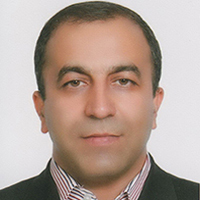Determining the best radiation model for Hargreaves-Samani equation in Shahrekord plain using lysimeter data
Abstract:
Different equations have been introduced for estimating grass reference evapotranspiration (ETo) that are in the range of easy to very complex equation of energy balance. Empirical ETo equations have remained in popular use because of simplicity and the smaller number of input parameters needed for computation. The Hargreaves−Samani (1985) equation is one of the empirical equations which widely used by researchers for estimating the ETo. The most important parameters in estimating ETo are temperature and solar radiation (Rs). The RS has a key role in energy balance in the ground-atmosphere system and is a key parameter in calculating ETo. Hargreaves and Samani (1982) recommended a simple equation to estimate solar radiation (Rs): R_S=(KT)(R_a) 〖(TD)〗^0.5 (1) Combining equation 1 with the original Hargreaves equation (Hansen et al, 1979) resulted in a simplified equation which requires only temperature and latitude (Hargreaves and Samani, 1982, 1985). The simplified equation is as:ET_o=0.0135 (KT)(R_a) (TD)^0.5 (T+17.8) (2)In the above equations, TD is the difference between maximum and minimum daily air temperature (Tmax-Tmin) (oC) for weekly or monthly periods; Ra is extraterrestrial radiation (mm/day); KT is empirical coefficient and T is the average daily air temperature (oC). The equation 2 and its empirical coefficient (KT) were investigated in various studies and its application in ETo proper estimation was validated. Ever now it was not done any study about the effect of solar radiation estimation methods on the results of Hargreaves-Samani ETo equation in Shahrekord plain. In the present study, the effect of 8 radiation estimation models on estimating ETo by Hargreaves-Samani model based on lysimeter measurements was investigated. This study was carried out in the agricultural station of Shahrekord in Charmahal-va-Bakhtiari province in Karoon basin, Iran. The experimental site is characterized with cold semi humid climate, altitude 2070 m above sea level, mean annual air temperature equals to 12.02 oC and average annual precipitation of 321.5 mm (Mahdavi et al, 2011). The present study was done by using a volumetric lysimeter planted with alfalfa in the Agricultural Research Center of Charmahal-va-Bakhtiari province in 2011. The date of the beginning and end of the measurement was on 21 April and 22 October 2011, respectively. In the next of the lysimeter, a drainage water measuring hole was constructed. The time of irrigation was based on 50% of maximum allowable depletion (MAD) of soil moisture and this amount was applied based on measuring the soil moisture in depth of 180 centimeters of the lysimeter. Meteorological data used in this study were collected from the weather station of Agricultural Research Center of Shahrekord in 2011. The used meteorological variables were maximum, minimum and average daily air temperature, solar radiation (RS), precipitation, wind speed, soil temperature, dew point temperature, sunshine hours, relative humidity, cloudiness ratio and evaporation from pan. The amount of Rs was calculated from 8 estimation models including Hargreaves-Samani (HS), Doorenbos- Pruitt, Annandale et al, Allen, Ertekin-Yaldiz, Samani, Goodin et al and Mahmood-Hubbard. Then ETo calculated from HS equation based on the Rs resulted from the radiation models was compared with ETo measured by lysimeter. For evaluating model accuracy, some indices include mean bias error (MBE), root mean square error (RMSE), relative error (RE), coefficient of determination (R2), index of agreement (d) and model efficiency (ME) were used.The results showed that the Hargreaves-Samani equation had underestimation based on more Rs models. With respect to differences related to lysimeter data, the Goodin et al and Ertekin-Yaldiz models had the poorest results. Also ETo calculated from Mahmood-Hubbard and Annandale et al models had the best results with 8% and 10% underestimation, respectively. With respect to all the evaluation criteria, it can be concluded that the Mahmood-Hubbard is the best solar radiation model with respect to effecting on calculating ETo in the climate of the present study and the Annandale et al model is in the next order. Also the Goodin et al and Samani are the poorest models in the solar radiation estimation. The Mahmood-Hubbard model generally has more physically base and obtained under various conditions and 9 years data. For this reason, probably the model had the best results in calculating ETo. Also the Annandale et al model takes into account the effect of elevation and reduced thickness of the atmosphere on the primary Hargreaves-Samani model and because the area of study (Shahrekord plain) is a region of high elevation, therefore the Annandale et al model has been a proper model in second order in estimating ETo. The poor result of the Goodin et al model was probably because of obtaining the coefficients of this model under limited conditions.
Language:
Persian
Published:
Iranian Water Research Journal, Volume:9 Issue: 18, 2015
Page:
47
magiran.com/p1494911
دانلود و مطالعه متن این مقاله با یکی از روشهای زیر امکان پذیر است:
اشتراک شخصی
با عضویت و پرداخت آنلاین حق اشتراک یکساله به مبلغ 1,390,000ريال میتوانید 70 عنوان مطلب دانلود کنید!
اشتراک سازمانی
به کتابخانه دانشگاه یا محل کار خود پیشنهاد کنید تا اشتراک سازمانی این پایگاه را برای دسترسی نامحدود همه کاربران به متن مطالب تهیه نمایند!
توجه!
- حق عضویت دریافتی صرف حمایت از نشریات عضو و نگهداری، تکمیل و توسعه مگیران میشود.
- پرداخت حق اشتراک و دانلود مقالات اجازه بازنشر آن در سایر رسانههای چاپی و دیجیتال را به کاربر نمیدهد.
In order to view content subscription is required
Personal subscription
Subscribe magiran.com for 70 € euros via PayPal and download 70 articles during a year.
Organization subscription
Please contact us to subscribe your university or library for unlimited access!



